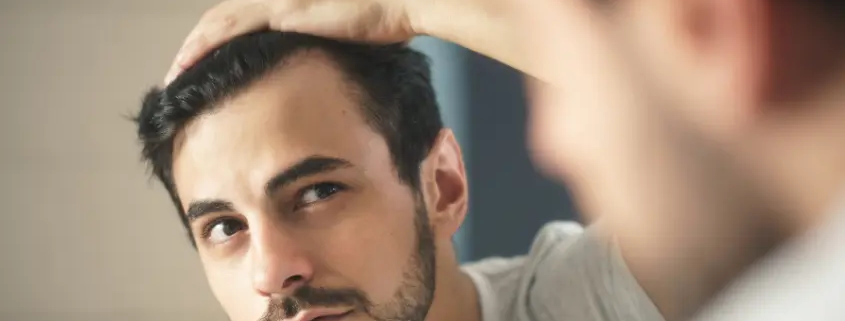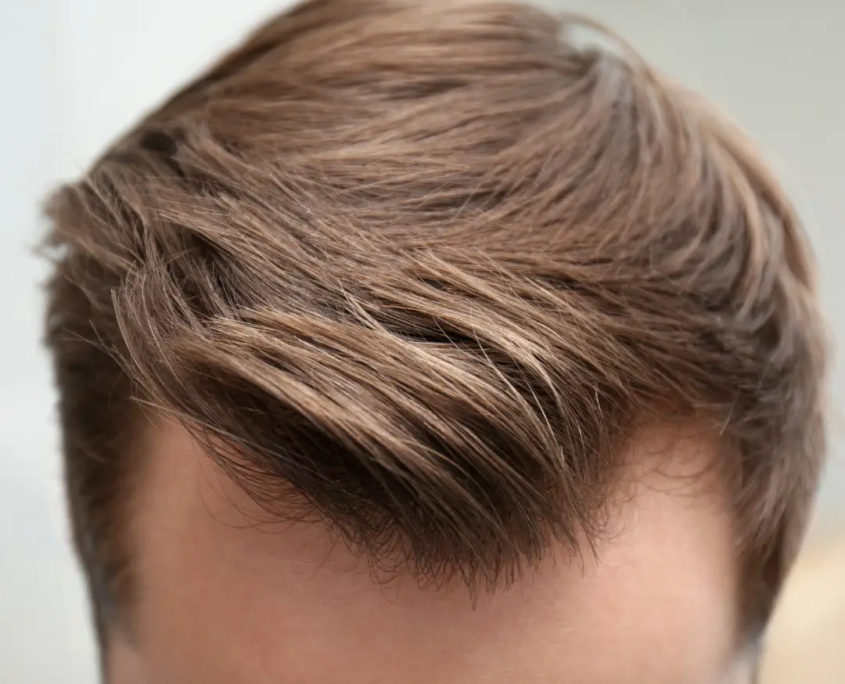What is an M-shaped Hairline? Is it a Sign of Hair Loss?
What is an M-shaped Hairline?
Male pattern baldness usually follows a predictable pattern. It begins with the hairline receding in the temples, which creates a distinct M shape. This pattern is commonly associated with hair loss and early signs of baldness. Sometimes, ladies might have a hairline that looks a bit like the ‘M’ shape seen in men. This is an ‘M-shaped hairline in females’. It’s like a hairline that’s moving back a bit.
Genes play a major role in the development of M-shaped hairline. Such genes can be passed on from either parent. Spotting receding hairlines early helps you get personalized hair loss treatment. It is often facilitated by hair DNA tests, tailored to your needs.
Is an M shape hairline normal?
An M shape hairline, also called a widow’s peak, is a normal hairline variation. It features a V-shaped point in the forehead where the hairline dips down. Some have a straight hairline, while others naturally have an M-shape or widow’s peak. This is normal and not a health concern. Many find M-shape hairlines unique and attractive. Around 30 to 50 percent of men face receding hairlines by age 50. Male pattern baldness is often the reason behind this. A study on over 450 Japanese men and women found interesting facts about their hairlines. More than 42% of men had an M-shaped hairline, where the hair recedes at the center forming an “M” shape. Nearly 33% had a widow’s peak, a V-shaped point in the hairline center. These variations show diverse and unique hair characteristics among people.
Are M-Shaped Hairlines Genetic?
Yes, an M-shaped hairline, like those seen in male pattern baldness, can run in families. Genetics plays a role in determining the M-shaped hairline or widow’s peak patterns. This means it can passed down from parents or grandparents. But it’s not genetics only—other things can also affect your hairline. Knowing about family history can help, but it’s not the only thing that decides your hairline shape.
What causes an “M” shaped hairline in men?
An “M” shape hairline in men is often due to male pattern baldness. Below are the primary factors contributing to the formation of an “M” shape hairline in men”:
1. Genetics: If your dad or grandpa has an “M” shape hairline, you might get one too.
2. Hormones: Some hormones in your body, like DHT, play a crucial role.
3. Ages: As you grow up, your hairline might start moving back. This usually happens when you’re a teenager or in your twenties.
4. Environmental factors such as stress or diet contribute to the development of an M-shape hairline.
Is M-shaped Hairline a Sign of Balding?
Yes, a M-shaped hairline is a sign of hair loss also known as male pattern baldness. In medical terms, it is called Androgenetic Alopecia. This is a result of a combination of genetic and dihydrotestosterone (DHT) hormones.
This type of hair loss pattern starts with a receding hairline on both sides, resembling stages 2-3 on the Norwood scale. Over time, hair loss may progress to hair thinning or complete baldness on the crown of the head.
Window Peak vs M-Shaped Hairline: What’s the Difference?
Some might liken an M-shaped hairline to a widow’s peak, as both display one section of hair lower on the forehead. You can spot the following differences:
Widow’s Peak:
a) A widow’s peak refers to a V-shaped hairline in the center of the forehead.
b) It appears as a small, downward-pointing triangle or peak of hair. It is a natural type of hairline.
c) Many people have a widow’s peak, and it is a natural type of hairline and not balding.
d) It can be more prominent in some men and women, depending on their hairline shape and density.
e) A widow’s peak hairline is not always a sign of female pattern baldness or Telogen Effluvium but a natural hairline.
M-shaped Hairline:
a. A receding hairline refers to the gradual loss of hair at the front of the scalp.
b. It starts at temples and moves backward, creating an “M” or horseshoe-shaped pattern.
c. This might be signs of male pattern hair loss or baldness.
d. Genetic factors, hormonal changes, and aging are the main factors for receding hairline.
e. Treatment options include medications, hair transplants, and wearing hairpieces.
In summary, a widow’s peak is a natural V-shaped hairline while a receding hairline is a gradual hair loss.
How to fix an M-shaped hairline?
It may not be possible to completely fix a receding hairline but you can take action to mitigate the hair loss. There are different ways to fix this type of hairline based on severity and your goals. Effective medications like minoxidil or finasteride promote hair growth and reduce hair loss. A hair transplant or hair restoration is a more invasive method to counter hair loss. Doctors transfer hair follicles from a donor area to an area on the head to make the thin areas less noticeable.
Hair Care Tips to Manage M-shaped Hairline!
It’s important to follow a proper hair care routine along with any treatments. Addressing lifestyle changes can be a crucial step in combating an M shape hairline. This can help keep your hair healthy while helping to slow down hair loss.
1. Diet: Remember to eat a balanced diet that has plenty of vitamins, minerals, and proteins. Include foods like eggs, fish, nuts, leafy greens, and fruits in your meals.
2. Harsh Styling: Excessive heat or chemical exposure harms your hair structure and follicles. Be gentle with your hair and avoid unnecessary stress on the follicles. Opt for “hairstyles for receding hairline” that cover your forehead, like bangs.
3. Practice Good Scalp Care: Wash your hair with mild shampoo to keep your scalp clean and healthy. Avoid excessive scratching or rubbing, as it can damage hair follicles.
4. Manage Stress: Chronic stress can contribute to hair loss. Make sure to include emotional stress management techniques in your daily routine. These include regular exercise, meditation, and proper sleep.
5. Hairstyles: For an M-shaped hairline, consider hairstyles with side-swept bangs or layered cuts. It helps to complement and soften the forehead.
HairLife: A Hair Loss DNA test at GeneHabit!
Discover the reason behind hair loss and receding hairlines with HairLife. Understanding the real cause is crucial for personalized treatment. HairLife report provides personalized hair care products and hair loss treatment. The test also advises on the best nutrition plans for healthy hair.
Frequently Asked Questions
Is an "M-shaped" hairline always from family genes?
Genes do play a part, but things like hormones or stress can also make your hairline look this way.
How are male pattern baldness and an "M-shaped" hairline related?
The M-shaped hairline is a clear sign of male pattern baldness. It is often among the initial and prominent signs of hair loss in males.
What is an unven hairline?
An uneven hairline means it’s not straight across the forehead.
Book a consultation
Simply fill in your details in the form below and we’ll get in touch with you shortly.







